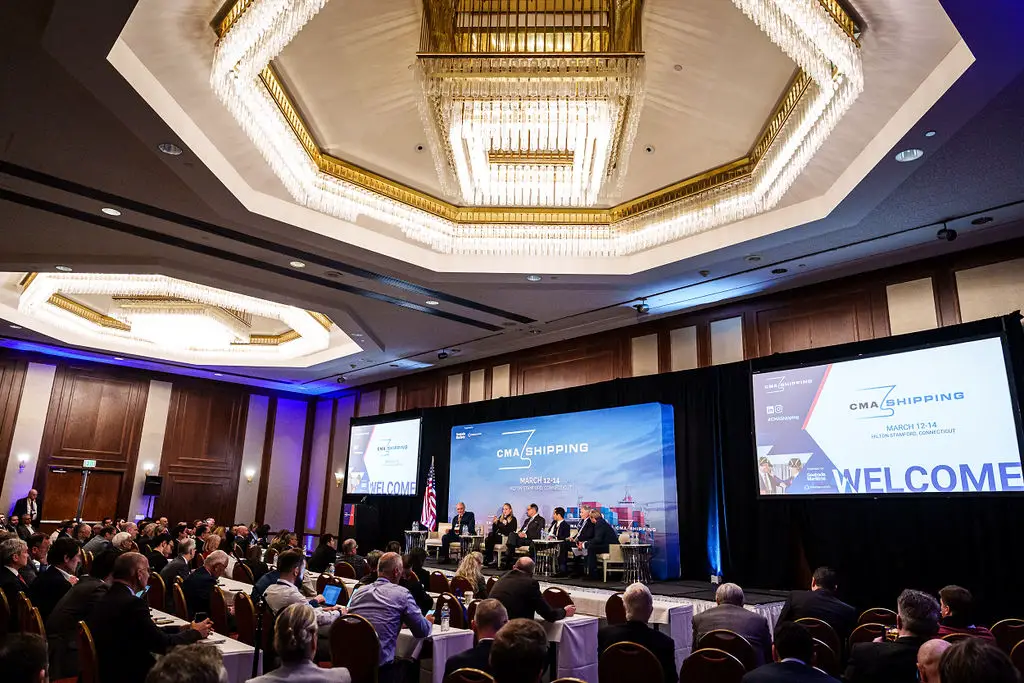
In early March, local members of the shipping industry and business leaders from around the globe met in Stamford for the 2024 Connecticut Maritime Association (CMA) Shipping Conference.
Chris Morley, the Group Director of Maritime Events at Informa Markets, which organizes several such conferences around the world every year estimated that altogether they see around 100,000 people every year but that the CMA conference is unique as a place to do business.
“There are kind of two models,” Morley said. “There’s scale where you bring lots of suppliers and lots of buyers into one great big room. And then you have a quality, slightly more niche and targeted approach. This conference is the latter.”
“The quality of attendee at this particular show, because of the community and the businesses based here in Connecticut is outstanding.”
In an increasingly globalized world few industries are as important or far reaching as shipping. Products that the entire world uses every day depend on effective maritime shipping. Even for domestic products many components may be sourced from abroad or depend on raw materials that originate from overseas.
“The goal of the CMA Shipping Conference every year is to bring our community together,” said Sandi Ennor, the current CMA President and owner of the New Canaan-based marine fuels brokerage Transparensea Fuels. “There’s a very large shipping and maritime community in the state of Connecticut, and we come together to discuss the pressing issues of the day, network with our colleagues, and give people an opportunity to exhibit the newest technologies. Every year we are blown away by the advancements presented by our exhibitors and to catch up with old friends.”
Those exhibitors included vendors promoting maritime staffing solutions, training programs, specialist publications, radar systems, marine paints, and robots designed to clean barnacles and other speed-sapping growths off ship hulls. Also in attendance were various clubs, insurance agencies, and international ship registry offices.

Among the old friends, the CMA has more than 800 members, and counts not only many people from across the region with ties to shipping and associated industries but also abroad. The conference has been held in Stamford for the past 35 years according to Ennor, outlasting several changes of management at their preferred venue.
“The founding members had a maritime community here, and they wanted a place where everyone could meet, get together socially, and exchange information or say, how are you dealing with this problem in our industry?” said CMA Vice President Beth Wilson Jordan.
Stamford is also a logical place for the annual conference according to Ennor, as it is accessible to local residents while being easily reached from New York City, its adjacent shipping facilities, and several international airports.
“Our organization is very events driven,” Ennor added. “With Covid we didn’t have an opportunity for close to two years where we could have a live event. I feel like this year is close to where it was pre-Covid.”
“Lots of geopolitical issues, specifically focused on the Red Sea and how that relates to earnings for shippers, and how did those costs get passed on to the end consumer,” said Ennor. “Because let’s face it, everything everybody touches has probably come on a ship.”
“Half the world would freeze, and the other half would starve, if it weren’t for shipping,” said Jordan, noting that it is an industry that typically only receives media attention when there is a major problem despite impacting the entire world daily.
Environmental and Social corporate Governance (ESG) topics were widely discussed and featured in several panel discussions and presentations made during the many breakout sessions during the conference Ennor noted. Environmental issues like the low water levels that threatened passage through the Panama Canal were unavoidable, as were discussions of recruiting and retaining top talent, an issue present in almost every sector.
“We talk a lot about attracting talent and people that aren’t necessarily in the industry and getting our industry on the radar of young kids,” said Vice President Jordan. “We work with Brien McMahon High School a lot. We let students come and look through the exhibits and we had students participate in a panel this year. Employers want to know what they’re thinking,, what’s important to them.”
Jordan said that one of the 15 students to attend was seated on a panel and given an opportunity to speak about what has attracted him to the field and decide to attend a maritime academy.
She also explained that the conference can attract people with less obvious links to the industry, such as a biologist who attended with a background in genetic testing.
“She is now working on a microbe that eats carbon and sort of poops out methanol,” Jordan said. “There’s somebody you wouldn’t normally think of being part of our industry.”
Ennor agreed, noting that biofuel feedstock involves many emerging technologies being developed in the center of the country, far from major harbors, but who might have very good reason to seek out the CMA.
“You have people that are farmers essentially trying to figure out how they can market their product that will eventually be turned into a biofuel to drive a ship sailing out of New York Harbor,” Ennor said. She allowed that some direct link to a maritime industry is necessary for CMA membership but said that conference attendance is not restricted and that local connections can be valuable for all parties.
To learn more about the CMA, visit https://cmaa.memberclicks.net/



















